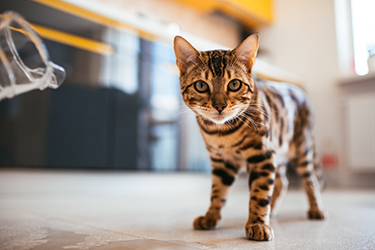Going to the Vet from a Cat’s POV

Is the cat a sensory seeker or avoider?
Taking a cat to a veterinary appointment can be stressful for both the cat and the owner. Making your clients aware of what will lessen that stress and what actually causes it will be beneficial for everyone involved.
Sensory overload is a condition that is typically associated with humans, but cats and dogs are capable of feeling it as well. Animals do not process information in the same way as humans. They feel distress when the noise level is too loud or the room is too bright because they do not understand why it is happening and have no control over their environment. It is important to inform your clients of how the waiting room environment might affect their cats.
What are cats hearing?
Feline hearing is significantly more acute than human hearing. A cat’s ear can rotate up to 180 degrees, hear even the faintest of sounds and pinpoint the origin of a squeak from up to three feet away. Cats can even hear at higher frequencies than dogs, which are known to have a strong hearing sense.
For cats that haven’t been socialized to cope with stimuli, walking into a busy lobby full of unfamiliar sounds can be startling. For the clients with cats that are not accustomed to loud noises or busy areas, you might suggest waiting in another room. You even could recommend they wait in the car until you or a staff member come to get them.
What are cats seeing?
Cat vision differs significantly from human vision. Studies have shown that cats have a wider field of view and a greater range of peripheral vision. They also have exponentially better night vision because their eyes have between six and eight more rod cells than human eyes, making them much more sensitive to low light. Felines also have limited color perception. As a result, humans can detect motion more accurately in bright light.
Because cats do not have the optical muscles needed to change the shape of their eyes lenses, they are essentially nearsighted. This simple fact can make all the difference for a cat sitting in a brightly lit waiting room. Unfamiliar surroundings and other animals approaching could cause panic. Keeping the cat in a carrier and away for other animals could help promote calm.
What are cats thinking?
Cats are very sensitive by nature. The slightest change in their environment can cause stress. The most common sign of feline stress is inappropriate urination or spraying. Stressors can include moving into a new home, visiting the vet or even moving a piece of furniture.
Most pet owners are aware that physical changes in the environment can cause stress. However, do they know their own feelings can have a profound effect? Cats share a deep emotional bond with their people. Their sensitive nature makes them susceptible to empathy. Remind your clients that is important to create a stress-free environment for themselves and their cats.
What can your clients do to make the visit more comfortable?
The Humane Society of the United States offers four essential tips your clients should know about taking their cats to the vet:
- Get the cat accustomed the carrier. This means using treats to train the cat to enjoy the space, making sure it is large enough for the cat to move around and considering the use of a calming spray inside. It is also helpful to use a toy or blanket with a familiar scent.
- Find a cat-friendly vet. This means finding a clinic that set up the waiting area in a way that accommodates felines specifically.
- Praise your cat for good behavior. Verbal praise and gentle stroking make a cat feel loved and calm.
- Arrive prepared. Write down questions and concerns. Give the cat at-home exams to be more informed with what is going on in your cat’s body.
Understanding what a cat is feeling, seeing, hearing and thinking in the veterinary office are the first steps in proper care. More importantly, it is crucial for your clients to understand this so that they can properly prepare for a visit.
Vet Street offers a list of ways people cause stress to their cats that you can provide to your clients.
Fear Free is a great resource for veterinary professionals. It provides online and in-person training to provide learners with the knowledge to support the emotional well-being of pets.
Contact your Covetrus representative for more information at 855.724.3461 or online.
Sources:
https://www.livescience.com/40459-what-do-cats-see.html
http://www.animalplanet.com/pets/cat-ears-hearing/
https://feline-nutrition.org/health/feeling-stressed-so-is-your-cat
http://www.humanesociety.org/animals/cats/tips/take-cat-vet.html
Careers
Are you looking for a place to let your talents shine? At Covetrus, we help our practitioner customers better serve their patients and take pride in providing the best customer experience possible. Search our open positions to see our available opportunities.
Newsletter
Stay current with what’s going on with Covetrus, subscribe to receive our newsletter and email communications. Subscribers will receive the latest information in practice management, sales and marketing, animal health, and more.


Leave a comment